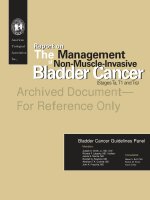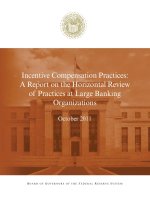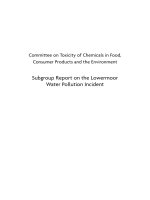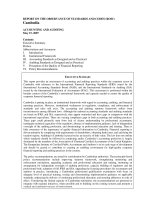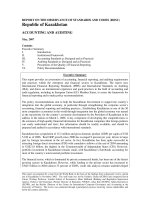Report on the EFA “Contains/May Contain – Food Allergen Labelling” Event potx
Bạn đang xem bản rút gọn của tài liệu. Xem và tải ngay bản đầy đủ của tài liệu tại đây (746.06 KB, 8 trang )
EFA (European Federation of Allergy and Airways Diseases Patients' Associations)
35, Rue du Congrès – B-1000 Brussels – Tel.: +32 (0)2 227 2712 – Fax: +32 (0)2 218 3141 – E-mail:
www.efanet.org
Report on the EFA “Contains/May Contain – Food
Allergen Labelling” Event
For food allergy patients, along with people who have hypersensitivities and intolerances, there are
numerous issues of significance with the labelling of food items in Europe. Inaccurate, unavailable or
misleading information, low readability, untrustworthy precautionary labelling for cross
contamination, recipe changes or strange ingredients and language barriers are all equally
concerning and can result in poor quality of life or nutrition, fear, restrictions, social isolation and
even death. With this perspective, on the 19
th
of September 2012 at the European Parliament, the
European Federation for Allergy and Airways Diseases Patients’ Associations (
EFA) organised an
event specifically addressing “Contains/May Contain – Food Allergen Labelling.” Over the past year,
the EFA Food Allergy Working Group has worked diligently to specify the topic as warranting a
broader public dialogue in the context of the new EU Regulation on Food Information to Consumers.
The event was coordinated by EFA’s EU Policy and Project Officer, Ms. Roberta Savli, in collaboration
with our long standing partner the European Academy of Allergy and Clinical Immunology (
EAACI)
represented by Prof. Antonella Muraro Chair of the EAACI Food Allergy Guidelines project and EAACI
Treasurer. It was hosted by Mrs. Renate Sommer, MEP, and Rapporteur of the Regulation.
The occasion attracted approximately eighty participants, serving as a unique opportunity for a wide
variety of stakeholders, including patients, policymakers, industry and NGOs to share experiences
and learn about best practices from around Europe. The discussions were divided into two distinct
segments focused on separate topics. The first half of the event consisted of a plenary with
presentations from experts on food allergy and the new EU regulation on the provision of food
information to consumers. The second half consisted of two panels with short and informative
presentations on best practices towards achieving compliance to the new regulation.
- 2 -
Getting the Right
Information to Patients
Defining Expectations from
Allergy Patients
The discussion initiated with MEP Renate
Sommer (European People’s Party, EPP, from
Germany) making a statement on her own
perspective on food allergy patients as well as
people who suffer food intolerances and
sensitivities. Her attendance was especially
valuable with consideration to her role as
rapporteur at the European Parliament (EP)
for the new EU regulation on the provision of
food information to consumers, which was
adopted by the EP and the Council of the EU in
October 2011 and whose provisions need to
be transposed into national legislations by
December 2014.
After reviewing her experience working on the
topic of food labelling as a member of the
Environment, Public Health and Food Safety
(
ENVI) Committee at the EP, she encouraged
all the stakeholders present to cooperate in
promoting best practices for food labelling
across Europe and improve the lives of people
with food allergy.
“We should agree on what the
‘may contain’ labelling means.”
- Susanna Palkonen, EFA Executive Officer
Afterwards, the expectations of allergy
patients were presented to stakeholders by
EFA Executive Officer Susanna Palkonen on
behalf of the EFA Food Allergy Working Group
in attendance. She revealed 7 out of 10 severe
allergic reactions to food happen when people
are eating out and emphasised serious
reactions have resulted from ‘may contain’
labelling.
Ms. Palkonen presented the advocacy activity
EFA undertook during the discussion of the
new EU regulation, especially concerning:
• For pre-packed food, 3mm font size
and contrast between writing and
background
•
Changes in recipe clearly mentioned
followed by allergen on main side of
packaging
•
For non pre-packed food, mandatory
labelling of allergen or availability of
information in a written form
wherever food is sold
•
Complete and accurate ingredients
list by food business operator on
delivery
- 3 -
• Training of personnel in food industry
to prevent cross contamination
Additionally, Ms. Palkonen insisted “may
contain” labelling should never be used unless
all reasonable precautions have been taken
during the production of a food product, good
practices are in use and food industry
employees received awareness and practical
workplace training on food allergy.
Defining Food Allergy and its
Impact on Europeans
In her presentation on behalf of EAACI, Prof
Antonella Muraro, Chair of the EAACI Food
Allergy Guidelines Initiative, explained the
adverse health effects arising from food
allergies to the audience while differentiating
between allergy, hypersensitivities and
intolerances. She also overviewed common
symptoms (vomiting, oral allergy syndrome,
etc.) as well as the difference between
systemic (anaphylaxis) and single/associated
(atopic dermatitis, rhinitis, asthma, etc.)
manifestations of food allergy.
Afterwards, the prevalence of food allergy was
highlighted in various studies demonstrating
38.4% of school children in Germany and
11.6% to 12.4% of UK teenagers showed
adverse reactions to some foods. Prof. Muraro
confirmed 1 child of 4 in Europe suffers from
some kind of allergy and she underscored
food allergy as the leading cause of
anaphylaxis, a life-threatening reaction in
children.
Since it is undeniable food is
everywhere in daily life, a management
strategy was suggested as a means for
alleviating the burden of food allergy:
1. Proper diagnosis of food allergy
2. Management of elimination diet
3. Management of severe reactions
4. Implementation of preventative
measures at school and in the
community
Prof. Muraro concluded by inviting
stakeholders to actively follow EAACI’s
Food
Allergy Campaign and consider participation in
the EAACI Food Allergy and Anaphylaxis
Meeting (
FAAM 2013) next year from the 7
th
to the 9
th
Everyday Experiences from the
Life of a Food Allergy Patient
of February in Nice, France.
Djoeke Kunnen spoke as a food allergy patient
on behalf of the Dutch Food Allergy
Organisation (
Stichting Voedselallergie) to
provide patient perspective. Mrs. Kunnen
spoke from her own experience as a patient in
addition to being a mother of a child who is
severely allergic to eggs among other foods.
She expanded upon the psychological effects
of parenting with a food allergy, and the
traumatic experience of feeling completely
helpless during her hospitalisation for a life-
threatening anaphylactic reaction with her
children present.
As a parent, Mrs. Kunnen emphasised the
social pressure of being outcast as “different”
for having different dietary “needs.” This kind
of pressure is felt when she and her family go
- 4 -
to barbecues in the Netherlands and all
popular nut products are removed to
accommodate her needs or when her child
asks a vendor to list the allergens within a
food product at a market. She explained to the
audience her frustration with inconsistencies
in food labelling and how helpful a consistent
approach could be for people with food
allergy, intolerances and hypersensitivities.
“Food should be safe, but primarily
tasty and fun!”
- Djoeke Kunnen, food allergy patient
Policy Developments for
Labelling of Food Allergens in
the EU
Speaking on behalf of the European
Commission, Alexandra Nikolakopoulou from
the
Directorate General for Health and
Consumers (Unit E.4, Nutrition, food
composition and information) provided
audience members with the newest
developments concerning food allergen
labelling. Her presentation touched upon the
differences between the existing legal
framework, Directive 2000/13/EC and the new
legal framework, Regulation (EU) No.
1169/2011, which will come into force as of
December 2014.
Existing legislation requires the listing of
allergens visible in Annex IIIa on product labels
while there is no obligation to label allergens
which do not appear in the annex. The
presence of allergens must be indicated with
the word “contains” where no listing of
ingredients is required but is not required
where the name of the food refers to the
allergen in question. Additionally, the
unintentional presence of allergens is not
covered by the legislation; this implies cross
contamination is an issue which is not
addressed.
The new regulation maintains the same list of
allergens (now listed in Annex II). However,
the Commission must update the list through
the means of delegated acts on the basis of
the European Food Safety Authority’s (
EFSA)
opinion on the issue, which is expected by the
end of 2014. Differently from the previous
directive, the new provisions require a more
direct link between all allergen derivatives
with the name of the allergen, as well as a
clearer distinction through a typeset between
allergens and the other items on an ingredient
list.
In addition, she enthusiastically informed of
an obligation to provide information on
- 5 -
allergens in non pre-packed foods including
those sold in restaurants and catering,
although it is up to individual EU member
states to decide upon the best means for this
requirement. Lastly, although no deadline has
been set yet, the Commission is required to
harmonise rules for addressing the
unintentional contamination of foods with
allergens (precautionary labeling).
Explaining Risk Assessments for
Food Allergens
In the final presentation of the plenary
session, Dr. Silvia Valtueña Martínez,
speaking on behalf of the European Food
Safety Authority (
EFSA), discussed risk
assessment for food allergen labelling in the
EU. EFSA was described as “an advisor” of
allergenic foods and products in assessing the
likelihood of triggering allergic reactions of
serious severity in susceptible individuals
upon the consumption of a given foodstuff.
The assessments are based upon scientific
research and rigorous evaluation of its
substantiating measures. EFSA is also vital for
approving a list of exemptions from the
existing and future legal frameworks. Ongoing
work at EFSA includes the possible
identification of “emerging” allergens and
review of the foods/ingredients listed in
Annex IIIa of the existing legal framework.
What are the best
practices around the EU?
Compulsory Information on
Allergen for Non Pre-packed
Food
The first panel discussion regarding best
practices on the provision of allergen
information for non pre-packed food began
with Mr. Stephen Pugh and Dr. Chun-Han
Chan respectively from the Department for
Environment, Food and Rural Affairs (
Defra)
and the UK Food Standards Agency (
FSA). They
overviewed specific cases of teenagers in the
UK dying of take-out food, highlighting the
gravity of food allergies. They also shared the
UK FSA’s practice guidance on giving allergen
information for non pre-packed food. Of
particular relevance was their
Voluntary Best
Practice Guidance
Ms. Hanna Magdalena Spangenberg
continued the discussion on behalf of the
Italian enterprise
for food vendors, which
encourages “two way dialogue” between non
pre-packed food providers and customers.
Safe Label & Clear Food. The
company designed software called LabelToGo,
which aims to respond to EU legislation in
allowing the creation of label that
automatically reports allergens and
intolerances. In this system, a restaurant can
- 6 -
upload its recipes, while maintaining
confidentiality of ingredients from the public,
and people with food allergy and intolerances
can then download and print a label of the
allergens that would appear in food on the
restaurant’s menu.
In making a presentation on behalf of his
colleague, Mrs. Marianne Jarl, Mr. Per-Åke
Wecksell described the project “Great, an
allergic customer!” developed by the Swedish
Asthma and Allergy Association (
Astma och
Allergi Förbundet). This initiative is a two-step
training programme for restaurants and
catering to manage and declare allergens, and
as a consequence, receive a certificate and
endorsement from the association. In
addition, he informed that Sweden is going to
adopt national measures to enable customers
to get full knowledge of the ingredients of a
meal. In case of food allergy, this means not
only those allergens listed in the Annex II, but
all as people may have allergy to ingredients
not listed. A customer should have the right to
know all ingredients in a meal when he or she
asks for it:
• Before going to the restaurant (by
phone, e-mail, etc.)
• When entering the restaurant
• When ordering at the table
“Precautionary Labelling”
“Labelling that emphasises a risk of
contamination may never be used
as an excuse for poor controls and
hygiene management.”
- Bo Nilsson, Swedish Food Federation
The second panel discussion focused on the
precautionary labelling and started with Mr.
Bo Nilsson providing the Swedish Food
Federation’s (
Livsmedelsföretagen)
perspective. He presented the exemplary case
of the Swedish Food Sector Guidelines. He
specified “may contain” should only be used in
labelling when the risk for cross
contamination for each allergen in a product
line is:
1. Uncontrollable
2. Sporadic
3. Documented through cleaning
controls, test results or substantiated
consumer reactions
EFA EU Policy and Projects Officer Roberta
Savli then followed with a presentation on
patients’ perspective on “precautionary
labelling” and best practices collected from
EFA member associations. From a patients’
point of view, ”may contain” labelling reduces
choices available to allergic consumers, which
can consequently lead to frustration and risk-
- 7 -
taking behaviours. As a result, EFA asserts the
best long-term solution to the problem is to
completely abolish “may contain” labelling. In
the short-term, European common practice
guidance is needed based on the following:
precautionary labelling may only be used as
the ultimate solution after the
implementation of best practices to avoid
cross-contamination (allergen management as
part of hygiene/safety manual, awareness and
practical workplace training on food allergy for
workers, responsibility of food business
operators at each step of the distribution
chain). Ms. Savli cited various practices from
Switzerland, the UK, and Sweden, which have
provided guides for allergy patients to assist
their decision making alongside with the
legislation and best practice in place in these
countries.
Giorgio Salerni from Italian patient association
and EFA member
FEDERASMA Onlus
concluded the second panel discussion with a
presentation addressing a case-study on the
use of latex gloves during preparations of food
products. Mr. Salerni confirmed its
consequences for allergic patients and why
industry should avoid latex-based products by
all means possible as allergic reactions to latex
can even be fatal. With latex often in use
during food production chains in the form of
rubber gloves, the consequence can be the
contamination of food with latex. As a result,
three requests were made to European food
industry stakeholders:
1. Do not include glove use in your
Good Health Practices (GHP), if not
compulsory
2. If the use of gloves must be
prescribed, avoid latex gloves
3. If latex gloves are not avoided:
clearly inform the public food was
handled with latex gloves (e.g.
print on label)
Conclusions and Policy
Recommendations
EFA highlights the necessity to take food
allergy patients’ views into consideration in
the process of the implementation of the
provisions of the new EU regulation to help
ensure their right to safe choice of food and
the ability to live uncompromised lives. EFA
proposes the following action plan for Europe:
− The legibility of the label should be
improved with clearer provisions on the
contrast between the name of the
allergen and the background;
- 8 -
− For non pre-packed food mandatory
information on allergen should preferably
be in a written form wherever the
product is sold;
− Voluntary measures adopted by Member
States should address the issues of the
provision of the complete and accurate
ingredients list and mentioning clearly
allergen changes in the labelling;
− European guidance is needed on the use
of precautionary “may contain” labeling,
which could learn from the best practice
in use in Switzerland. In the long term,
precautionary labelling should be
abolished;
− European guidelines on the training of
personnel in the food sector concerning
the food allergen management as part of
hygiene/safety manuals should be
drafted.
EFA will be glad to work together with policy-
makers and other stakeholders to offer its and
its members’ expertise to reach the common
objective of preserving Europeans’ health.
Acknowledgements
The success of the EFA “Contains/May Contain
– Food Allergen Labelling” Event would not
have been possible without the support of
MEP Renate Sommer, EFA partner the EAACI
and the enthusiastic support from the EFA
Food Allergy Working Group members. These
include the Swedish Asthma and Allergy
Association, FEDERASMA Onlus, Norwegian
Asthma and Allergy Association (
Norges
Astma- og Allergiforbund), Allergy UK, Dutch
Food Allergy Organisation, French Association
for the Prevention of Allergies (
Association
Français pour la Prévention des Allergies),
Association of Bulgarians with Bronchial
Asthma, Belgian Prevention of Allergies
(
Prévention des Allergies) and Danish Asthma
and Allergy Association (
Astma-Allergi
Forbundet). EFA also thanks all participating
speakers for attending the event and
presenting either their personal views or
those of their organisations.
This report was written by David Brennan, EFA
with input from his colleagues at EFA office.
Further Information
All presentations from the event are available
for download as PDF files on the new
EFA
website at:
EFA and EAACI’s joint
press release for the
event is also available for download from
EFA’s website as a
Word doc or PDF file.
Photos taken by
David Plas are available to the
public for viewing in his
online gallery for the
event.
